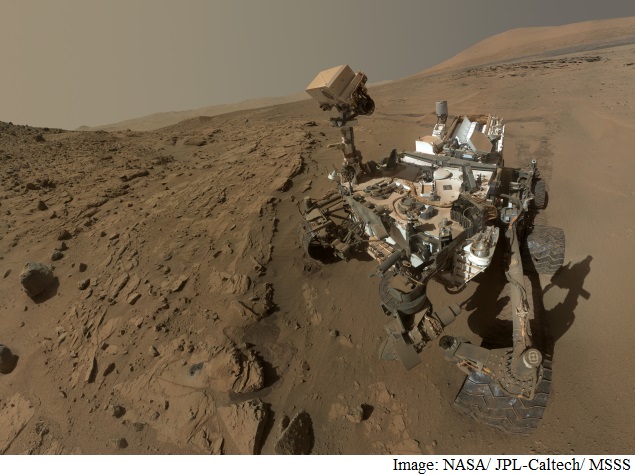- Home
- Science
- Science News
- Nasa's Curiosity Rover Finds Organic Matter on Mars
Nasa's Curiosity Rover Finds Organic Matter on Mars

The organic molecules, found by the team responsible for the Sample Analysis at Mars (SAM) instrument suite on Curiosity, were in a drilled sample of the Sheepbed mudstone in Gale crater - the rover's landing site - the US space agency said in a statement.
Organic molecules consist of a wide variety of molecules made primarily of carbon, hydrogen, and oxygen atoms.
However, organic molecules can also be made by chemical reactions that do not involve life.
Examples of non-biological sources include chemical reactions in water at ancient Martian hot springs or delivery of organic material to Mars by interplanetary dust or fragments of asteroids and comets.
The surface of Mars is currently inhospitable to life as we know it, but there is evidence that the Red Planet once had a climate that could have supported life billions of years ago.
"We think life began on Earth around 3.8 billion years ago and our result shows that places on Mars had the same conditions at that time - liquid water, a warm environment and organic matter," said Caroline Freissinet of Nasa's Goddard Space Flight Center in Greenbelt, Maryland, US.
For example, features resembling dry riverbeds and minerals that only form in the presence of liquid water have been discovered on the Martian surface.
The organic molecules found by the team also have chlorine atoms and include chlorobenzene and several dichloroalkanes, such as dichloroethane.
The Curiosity rover with its suite of instruments including SAM was sent to Mars in 2011 to discover more about the ancient habitable Martian environment by examining clues in the chemistry of rocks and the atmosphere.
Scientists think the crater was once the site of a lake billions of years ago and rocks like mudstone formed from sediment in the lake.
While the team cannot conclude that there was life at Gale crater, the discovery shows that the ancient environment offered a supply of reduced organic molecules for use as building blocks for life and an energy source for life.
Curiosity's earlier analysis of this same mudstone revealed that the environment offered water and chemical elements essential for life and a different chemical energy source.
Catch the latest from the Consumer Electronics Show on Gadgets 360, at our CES 2026 hub.
Related Stories
- Samsung Galaxy Unpacked 2025
- ChatGPT
- Redmi Note 14 Pro+
- iPhone 16
- Apple Vision Pro
- Oneplus 12
- OnePlus Nord CE 3 Lite 5G
- iPhone 13
- Xiaomi 14 Pro
- Oppo Find N3
- Tecno Spark Go (2023)
- Realme V30
- Best Phones Under 25000
- Samsung Galaxy S24 Series
- Cryptocurrency
- iQoo 12
- Samsung Galaxy S24 Ultra
- Giottus
- Samsung Galaxy Z Flip 5
- Apple 'Scary Fast'
- Housefull 5
- GoPro Hero 12 Black Review
- Invincible Season 2
- JioGlass
- HD Ready TV
- Laptop Under 50000
- Smartwatch Under 10000
- Latest Mobile Phones
- Compare Phones
- OPPO Reno 15 Pro Max
- Honor Win RT
- Honor Win
- Xiaomi 17 Ultra Leica Edition
- Xiaomi 17 Ultra
- Huawei Nova 15
- Huawei Nova 15 Pro
- Huawei Nova 15 Ultra
- Asus ProArt P16
- MacBook Pro 14-inch (M5, 2025)
- OPPO Pad Air 5
- Huawei MatePad 11.5 (2026)
- Xiaomi Watch 5
- Huawei Watch 10th Anniversary Edition
- Acerpure Nitro Z Series 100-inch QLED TV
- Samsung 43 Inch LED Ultra HD (4K) Smart TV (UA43UE81AFULXL)
- Asus ROG Ally
- Nintendo Switch Lite
- Haier 1.6 Ton 5 Star Inverter Split AC (HSU19G-MZAID5BN-INV)
- Haier 1.6 Ton 5 Star Inverter Split AC (HSU19G-MZAIM5BN-INV)

















